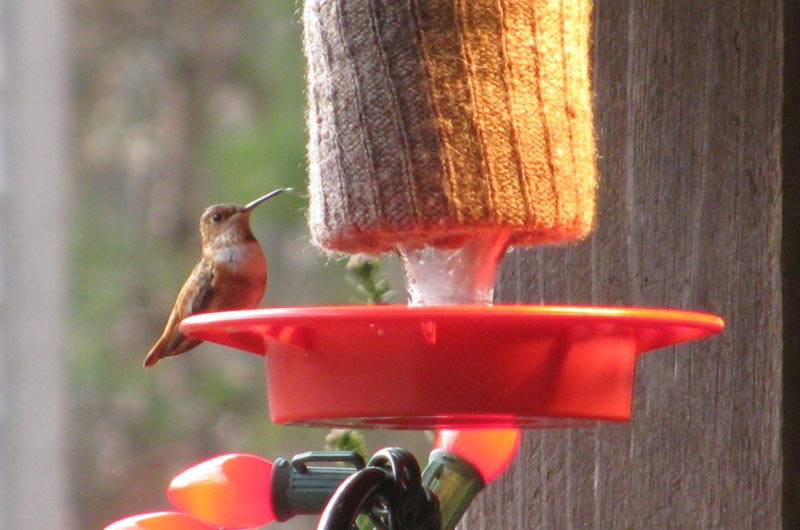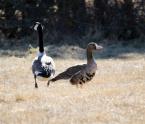Last week I began the column by writing about the death of David Masch, mentioning there would be a memorial on Sunday, Jan. 26, in Woods Hole. Since then though, the Masch/Swan household has informed me that the memorial for David is not open to the public.
Janet and Floyd Norton of Sweetened Water Farm in Edgartown have an awesome duck pond in their back yard. Over the years it has produced an impressive list of unusual waterfowl and herons. It is the place on the Vineyard where one could possibly find a shoveler, a pintail or a little blue heron. On Jan. 20 Janet called to say she had two snow geese in the field next to the pond. The next day she called in the morning to let me know that two more snow geese had arrived and shortly thereafter she called again to say that eight snow geese were in her yard. They were still there as of Jan. 23.
Snow geese aren’t always white with black wing tips and black “grin patches” on their bills. There is a blue morph, known as the blue goose. Unlike the snow geese that are visiting the Sweetened Water Farm, the blue goose has a white head but a brownish-blue body and blue wings. There have been a few blue geese seen on the Vineyard, but that is a rare occasion.
Both the snow and blue geese have pink bills with the black “grin patches,” which is an excellent field mark to separate them from the Ross’s goose. Immature snow and blue geese have black bills as do Ross’s, so size and leg color also must also be used for identification to determine which you are seeing.
Snow geese that we see on the Vineyard, which normally winter between Virginia and North Carolina, breed in the tundra between Ellesmere Island and Greenland. The colonies are huge, with numbers exceeding 1200 per square mile. The female incubates the eggs although the male stands guard for the 23 days needed before hatching. In 40 to 50 days the young take to the wing.
Check Vineyard fields that have had grain or other seed-producing plants for snow geese. Grain is the food of choice for the snow geese. They often are seen with Canada geese.
Bird Sightings
A report was sent to me from the Uhlendorf/Stevens household of Pilot Hill: the Allen’s hummingbird survived the first night of temperatures in the teens. On Jan. 23 he was feeding on a bottle hummingbird feeder that was wrapped in a red wool sock and warmed by Christmas tree lights, red in color of course! A bit further up-Island Joan Ames said her ruby-throated hummingbird was alive and was licking sugar water from the window where a bit of frozen sugar water fell as she took the feeder in to thaw. She put fresh unfrozen sugar water back outside and the ruby-throated hummingbird was happy as a clam.
Marianne Thomas called to say that she had a first for her Ocean Heights feeder. On Jan. 13 a common redpoll arrived and joined the rest of her flock of chickadees, nuthatches and juncos at her feeders. Marianne added that the redpoll stayed two days. Flip Harrington and I watched a common redpoll join our American goldfinches on our Chilmark thistle feeder on Jan. 22. The redpoll wasn’t in attendance on Jan. 23 at our feeder. Redpolls prefer pine seeds, so probably left our yards for the woods.
John Nelson counted 123 horned larks in the fields at the Farm Institute at Katama on Jan. 20, more than he had ever seen together on-Island and certainly more than I had! On Jan. 23 Ken Magnuson counted more than 50 horned larks in the same field and photographed a portion of them.
Judy Hathaway called the Bird Hotline to report that since Jan. 18 she has been watching a flock of American wigeon from the Boulevard on Sengekontacket Pond. She found that there was a Eurasian wigeon in with the flock of 10 Americans. The wigeon flock was being followed by a pair of black ducks.
Lanny McDowell took a series of photographs of ruby-crowned kinglets at Long Point, Tisbury Great Pond on Jan. 17. On Jan. 22, after the snow storm, Lanny had two pine warblers and two palm warblers feeding on suet at the feeders at the Tashmoo house. As Lanny noted, pine warblers stay around all winter but palm warblers are usually south by now.
Jeff Bernier photographed a red necked grebe which is still hanging around the Memorial Wharf as of Jan. 21.
I joined Flip Harrington, Larry Hepler and Bart Heywood on a jaunt out to Cape Pogue on Jan. 20. It was a beautiful afternoon and the sunset as we crossed Dyke Bridge to come home was spectacular. We watched a flock of over 100 common goldeneyes feeding near the lighthouse. We were sure there must be a Barrow’s in the mix but couldn’t find one. We saw long-tailed ducks and both surf and white-winged scoters as well as common eiders. Along Cape Pogue Bay there was a mix of herring, black-backed and ring-billed gulls feeding on scallops. The vast majority were herring. We spotted a Bonaparte’s gull there as well. We counted 80 sanderlings exploring the scallop shells after the gulls had left, either for leftovers or insects that were attracted by the leftovers. Two brant were feeding along the edge of the bay and buffleheads were out in the open water. We found the remains of a freshly killed barn owl by the lighthouse. One wonders if it was killed by a great horned owl?
Rob Culbert discovered that the turkey vulture roost is back at Rob Backus’ property in Tisbury. Rob found that the vultures, about 14 in total, arrive for the evening between three and four in the afternoon.
Please report your bird sightings to the Martha’s Vineyard Bird Hotline at 508-645-2913 or birds@mvgazette.com.
Susan B. Whiting is the co-author of Vineyard Birds and Vineyard Birds II. Her website is vineyardbirds2.com.








Comments
Comment policy »